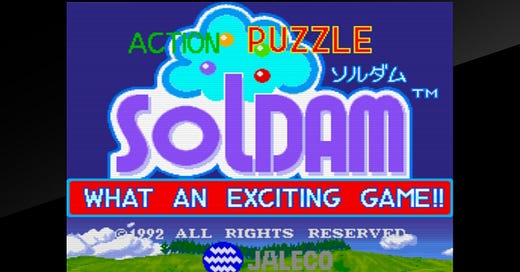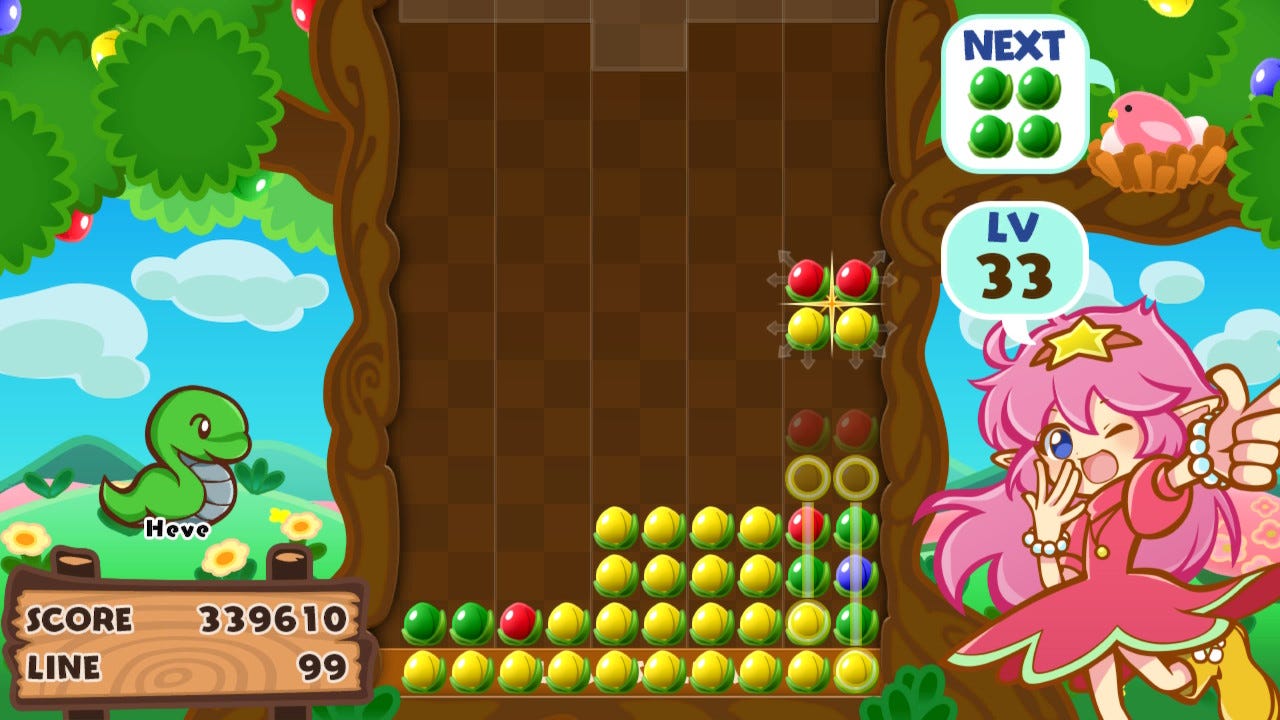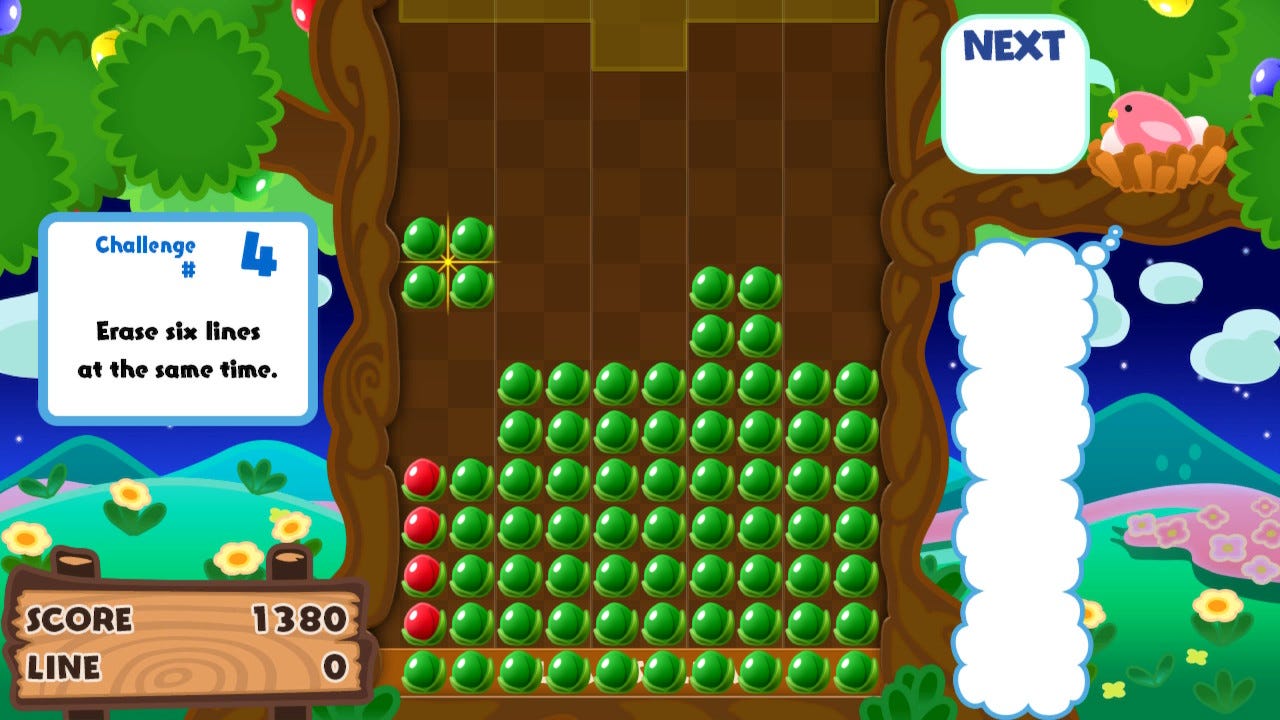It's new to me: Soldam
A pair of puzzle games, one from 1992 and developed by Jaleco, the other from 2017 and created by the company that now owns Jaleco's assets.
This column is “It’s new to me,” in which I’ll play a game I’ve never played before — of which there are still many despite my habits — and then write up my thoughts on the title, hopefully while doing existing fans justice. Previous entries in this series can be found through this link.
In 1990, Jaleco released a single-screen platformer for arcades called Rod Land. It’s an unfortunate name, yes, but the game itself was entertaining, and even received a couple of ports 8-bit ports to the NES and the Game Boy. Jaleco never made another Rod Land or a sequel to it, but they did release a puzzle game to arcades (with a port to the Game Boy in Japan) two years later featuring the characters of Rod Land: this time around, the name was better, too. Soldam is a falling block puzzle game where you clear lines, but this is no Tetris clone by any means. It has elements of Reversi in it, and rather than fitting shapes together like in Tetris or simply matching colors like in Columns, in Soldam, every piece is the same size and shape, and the trick of it is what colors your new pieces will turn your old pieces.
At its most basic, Soldam has you playing with two colors at a time. Four-square blocks will drop down onto your grid that’s 10 squares wide, broken down into five columns — pieces must be placed within a column, not spanning two columns. Sometimes those square blocks contain just one of the colors, sometimes a mix of two whether it’s one red and three blues, or one blue and three reds, or two of each in a couple of different patterns. Your goal is to clear a line of one of those colors all the way across the screen — horizontally only — which then fills in a horizontal line under the play area. Once you do this, Soldam really begins, as the colors you drop down interact with the color line underneath your play area to change the ones in between. This is how you go about clearing multiple lines together, converting larger sections of other colors to the one you want to focus on, and avoid losing because your blocks just keep stacking up up up until you run out of space.
As said, at its most basic, there are just two colors. The normal difficulty, which you can either start at or score your way toward, uses three colors, and hard uses four. That means, late-game, you can get squares that have one of each color, and can be a nightmare to place if you don’t have a good spot for them to go. The game has stretches where it speeds up, and then it will slow down back, depending on what level you’re at. (Like with other games of this type, the level goes up as you clear more lines.) It seems pretty daunting at first, as you figure out exactly how to get into the rhythm of being in control of what the colors will be: you’re never in control of what’s falling, but when you get the hang of efficient placement, you’ll be in control of what those colors will become, and how they’ll work for you.
The game warns you after a loss that trying to change your primary color can be dangerous, and it’s not kidding. Whatever you end up clearing first and placing into that section beneath, you’ll probably want to focus on converting everything else to that color as much as is possible. It’s not impossible to switch colors, but it requires clearing the bottom line to do so: if you’re desperate and need to clear another color close to the top, go for it of course, but you’re not going to want to permanently switch from blue to yellow, for instance, if you’ve been building everything up with clearing blue in mind and still have blue at the bottom. Here’s an example of why you don’t want to switch, from Soldam’s 2017 remake slash sequel, Drop, Connect, Erase:
You can see the line of yellow underneath the play area: notice how it will interact with the yellow pieces being brought down from the top? Those arrows show you that the greens, red, and blue pieces that will find themselves sandwiched between your yellows are going to convert to yellow themselves. It won’t clear a line now, but you just need to do the same thing to the greens and the red on the left with a later piece, and then things will start to clear. The number of pieces in between doesn’t matter so much — you could drop that next piece, the four green one, on top of those other greens, but if you can sandwich it all between yellows like is shown happening in this screenshot, they’ll all convert to yellow. These color conversions can also happen side-to-side and diagonally: it’s all about sandwiching colors between the same colors from various directions.
Soldam’s post-loss screen also gives you the hint of finding a place to put your unwanted pieces, and while it doesn’t tell you what it means by that, the example above is it. Place your non-primary colors in spots where the primary color is underneath them, because they won’t gum up the works there. They can be dealt with later, and work to your advantage. But if you just start panicking and throwing things wherever, you might interrupt the flow of building with your primary color, and find yourself dealing with a situation you can’t get out of.
There are three game modes in the original Soldam. The first is your traditional endless one, which you can begin on easy, normal, or hard: you get a built-in point bonus for starting on normal or hard, and that’s because the game is moving faster and with more colors, giving you less time to build the kind of base you’d be able to by starting on easy. When you reach level 10 in this endless mode, the music will change, and a third color will be added. If you manage to get to level 30, a fourth color will be added to the mix, the music will change again, and things will get faster, quicker: this is when you’ll be hoping you built a clearable tower of pieces underneath you and that reacting rather than thinking will be enough to get you by.
The music doesn’t begin as frantic as it sounds there at the start of the video: that’s just how sped up it gets by the time you’re in a position to be moving on from easy to normal. Hear how the new song that starts when you hit level 10 is slower? That’ll speed up as you go, too, to reflect the building tension and speed of the gameplay itself.
Then there’s the story mode, which gets increasingly difficult as you go, and even includes enemy characters from Rod Land who will do their best to impede your progress. You think you’re just moving along at a good pace, and then a crocodile starts throwing things at your blocks before you can place them, breaking them and interrupting whatever plan you had laid out. In addition to those enemies, you also swap out the game pieces from colored fruits to the little slime foes from Rod Land.
There are some new pieces in the story mode: a giant orb piece that isn’t associated with any specific color, but can only be cleared when you wipe two lines of the same color, and huge slimes that make up four pieces of the same color. There’s not much difference other than visual between those big slimes and the single-color pieces from the endless mode, but the effect of the big slime breaking apart and becoming four smaller slimes after you place it is still an appreciated little bit of effort to switch things up. The orb can be a pain if you don’t have a good place to put it down, but once you get used to accounting for their presence, they’re not so bad. Unless you get one as you’re inching close to the top of the play area, anyway. The first time you see them together on screen, the story mode tells you to try getting the massive slime next to the orb if you can: “…you’ll be lucky!”
The story mode also includes letters that spell “EXTRA,” and you don’t even have to clear a line to collect them, though, you can. All you need to do is convert them to a different color, and you’ll see the letter added to the side of the play area. When you spell extra out, just like in Rod Land, a fairy comes and gives you some massive point bonuses. In addition, the fairies also clear out your pile of slimes, which can save your game from certain disaster if you time things right. Observe:
From being real close to losing, warning chime included, to nabbing 80,000 points and getting a chance to keep playing. You’ll want to make sure you’re collecting all of those letters when they’re available, even if it means interrupting your standard play strategy a bit to do so.
Last is multiplayer, which scales down the size of the play area so that it’s just three squares wide rather than five (so, six spaces wide instead of 10), and makes it so that first player is red, second player is blue. That means first player can only clear red lines, and second player only blue. There’s another twist, too: you share what piece is next, so you’re basically in a race to get it or not get it, depending on whether it will help you or harm you.
Jaleco is no more, as they stopped making and publishing games back in 2006, and then dissolved in 2014 when its parent company underwent bankruptcy. A company called Clarice Disk would buy their assets, and rename themselves after one of them: that’s City Connection. City Connection specializes in picking up otherwise discarded properties and then re-releasing them in the present — both Rod Land and Soldam are part of Hamster’s Arcade Archives series on the Switch and Playstation 4 because of City Connection — and in the case of Soldam, they even created a pseudo sequel that, given what’s included, also just serves as a remake.
The gameplay is the same, though, not being an arcade release, it’s all a little more forgiving since you’ve already handed over your money. There’s a classic endless mode that’s just like the original game which has also folded the story mode into it, so you’ll see those characters you’re “fighting” against on the screen as you play. There’s also as an easy mode for beginners, which is where you should start to learn how to play if you’re not familiar with the arcade release. There’s a head-to-head mode here, too, and a series of 50 challenges that see you trying to complete specific tasks in a limited set of moves.
Challenge number four, displayed in the above image, begins without those leftmost pieces in place: you get three pieces to place, and there’s one solution for achieving your goal of wiping six lines at the same time. Put either of the first two pieces in the wrong place or wrong alignment, and you won’t be able to clear six lines with the final all-green one. There were more reds in that arrangement before, but placing those pieces how I did converted them to green, which left the reds I placed in a position to be converted to green with that final piece, using the line below the play area to sandwich them together. These challenges can teach you how to tackle the organic issues that arise in your play in the endless mode, so it’s worth playing them to add a few more tools to your toolbox, if nothing else.
The one downside of Drop, Connect, Erase is that it lacks online leaderboards, while the Arcade Archives release of Soldam has them. (Drop, Connect, Erase also doesn’t let you record video clips of your play for some reason, though your mileage may vary on how annoying that is.) The Arcade Archives edition of Soldam is pretty standard otherwise, with the kind of quality of life tweaks you expect from that series (save states, display options for scanlines and frames and such, button remapping), but if you’re really invested in the online leaderboards and want to go with the version that has those, it does have all you need to enjoy Soldam besides the challenge mode of Drop, Connect, Erase. They’re both $7.99, so at least it’s not going to leave a hole in your wallet if you do decide you’d like both. As for options in the updated edition of Soldam, you can choose to have it show you what will happen when you drop a piece in place, like in the screenshot way back at the top of this feature, or turn that off and figure it out for yourself as you play. Said option exists in the Arcade Archives release, too, but is turned off in the story mode: you’re on your own there, whether you want to be or not.
Soldam is obviously lesser-known compared to some of its contemporary giants in the falling pieces puzzle genre, but that at least in part has a lot to do with Jaleco not giving it a worldwide release, instead limiting itself to Japan and Europe. The gameplay is wonderful, and while you’ll be punished in a hurry for not getting it in a way that Tetris and Columns do not, it’s just as satisfying when it all comes together for you.
This newsletter is free for anyone to read, but if you’d like to support my ability to continue writing, you can become a Patreon supporter.






